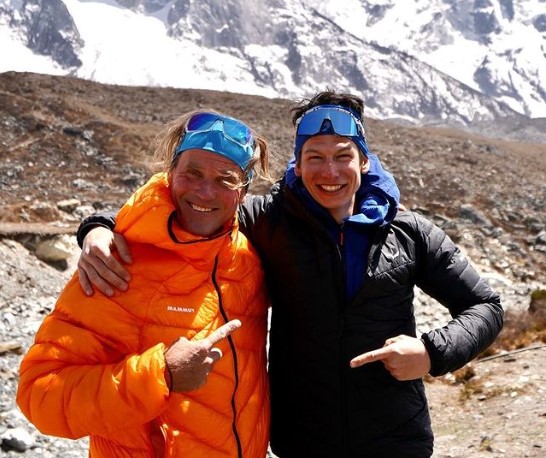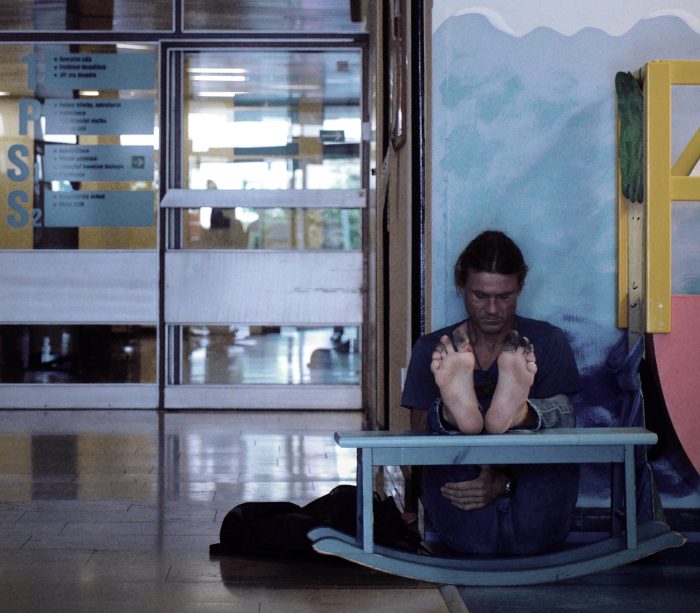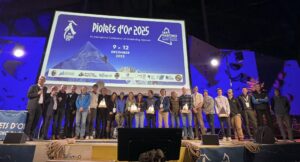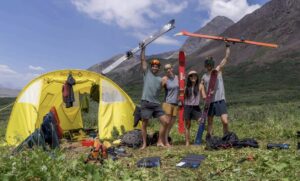Marek Holecek returned from his spring in Nepal with an impressive new route on a stunning peak. Completed in a pure alpine style, Holecek and Matej Bernat’s Sura Peak climb was hardly without risk. In fact, it was highly dangerous.
Sura Peak
Sura Peak (6,764m) lies in the Makalu-Barun Conservation Area, also known as Hongu. It is not far from the Khumbu, in the wilder Hongu Valley to the southeast. For the Czech climber, it’s long been a place full of hidden treasures.
“I first walked through the Hongu Valley in 2001 to attempt the southwest face of Kyashar Peak, which I finally summited in 2005,” Holecek told ExplorersWeb. “On this first trip, three snow queens haunted my dreams: Chamlang, Baruntse, and Sura Peak. Dreams have slowly turned into reality, step by step, over 20 years.”

Sura Peak, in the Makalu-Barun Conservation Area. Photo: Google Maps
The first challenge Holecek faced was finding a partner. None of his seasoned climbing friends replied positively, so he had to change the scope of his search.
“If there are no mature fish at the bottom of the pond, the fisherman must wade in shallower waters for young fry,” Holecek wrote at the time. “After a few formal phone calls, a young fish, Matej Bernat, was flipping about in the net.

Marek Holecek, left, and Matej Bernat in base camp. Photo: Marek Holecek
“Matej is a powerful 28-year-old machine,” Holecek told ExplorersWeb. “Professionally a dentist, he is an excellent endurance runner, a ski alpinist, and an experienced climber. His experience of big hills was almost nil, but in the Alps, he has climbed
and run all four thousand peaks.”
Holecek wanted to ensure that everything ran smoothly during the climb. “The only thing that bothered me was that thanks to his youth, he can waste energy unnecessarily,” Holecek said.
Alone to face the mountain
After two weeks acclimatizing in the region, the pair set up their base camp by a lake. They sent their porter back to the nearest village (in a different valley separated by a 5,500m mountain pass) and were alone with the mountain.

Holecek shaves in front of Sura Peak. Photo: Matej Bernat
The days were bitterly cold, and the mountain drier than in previous years. “Whether it was good for our climb or not remained to be seen,” Holecek said at the time.
They waited for a good weather report and finally set off from base camp toward the peak’s northwest face on May 19. They took food for five days.
From OK to hell
The first two days went well. They spent the first night at the bottom of the face and made great progress on the second day. They climbed up the lower ice slopes until the terrain reached 80º. Some sections of blue ice slowed them down, but by late afternoon, they found an ice cave just above 6,000m. It was a perfect bivy spot.
The following day, they faced their main challenge: a rock barrier crossing the entire face. They expected it would be hard, but according to Holecek, it was “hell on Earth.”

Climbing the ice barrier. Photo: Marek Holecek
‘We were in deep shit’
“The rock was broken, crumbly like gingerbread, sprinkled with loose snow sugar,” Holecek said. “The underlying security was very uncertain. Ice axes and crampons could slip out with a piece of rock at any moment. I felt that if it happened, not only would I fly down to the glacier, but the entirety of Sura Peak would fall on my head at the same time.”
To make matters worse, it started to snow. Progress was excruciatingly slow. As the light and their strength faded, they struggled to find anywhere to rest. Out of options, they tried to carve a platform into the 70º slope, only to expose bare rock a few centimeters below.
“We were in deep shit,” Holecek recalled.
We had to attach the canopy of the tent to the belay we were hanging from, which looked like a big garbage bag hung on a nail. We crammed into it with our sleeping bags and all our stuff, we made sure that nothing would fall. There was no support to lean on in the tent, so our bodies were sliding against the fabric. We were like two marionettes tied by strings to the middle of an inhospitable mountain face.
The second bivouac on the wall was hell: Video
The following day, the only choice was up, over an 80m section of overhanging rock. Somehow they made it. Holecek led the section slowly, completely focused on each step, each pitch.
“The rock sill was slightly overhanging from the start,” Holecek said. “When ice axes and crampons crunched against the rock, I just prayed they would hold in place. A fall would be fatal. Sometimes I displaced a whole wagonload of rocks. Fortunately, I didn’t hit Matej even once. While picking up the rope, Matej fell a few times and I again started to pray that the entire block where I had installed the belay would not fall out.”
After they surmounted the roof of the rock barrier, Bernat took the lead for two pitches of ice until he found a crack big enough for a bivy. “Another kiss of luck on a 70º slope,” Holecek wrote.

Picking on hard ice on the third day of climbing. Photo: Marek Holecek
The summit and descent
It took the climbers two hours to gain the remaining 140 vertical meters to the summit. They were exhausted and had to use all of their remaining strength to progress on hard ice with their ice axes.
Holecek admits that they only felt relief on the summit, rather than joy.

On the third day, approaching the crux of the climb. Photo: Marek Holecek
“I was looking at that rigid frozen beauty, trying to indelibly inscribe it in my memory again,” Holecek wrote of the summit. “However, the image never lasts long before it…disappears completely. The only thing that remains are the colorful memories of hardship, hard work, and the climbing partner with whom you underwent the martyrdom.”

Bernat leads the long, scary descent in loose snow. Photo: Marek Holecek
The climbers didn’t stay on top long. Bernat took the lead down the snowy southwest ridge and simul-climbing (roped-up but progressing at the same time, not belaying each other), tried to lose altitude quickly.
“The descent down the southwest ridge was endless and hard,” Holecek told ExplorersWeb. “[There were] no easy sections, you had to be sure, and in some places even rappel. I honestly thought that we wouldn’t be able to climb down to the rubble field that day, but luckily it worked.”
They left the snow behind as the sun set and continued out of the valley to a stone hut where porters and their friend Pawel awaited. They arrived at 11 pm.
Frostbite
The climb left them with a sense of achievement but also some scars.
“The fact that Matej and I were frostbitten became clear when we took off our shoes and gloves. Our toes only became more distinctly colored over the following days. I had a long recovery, until the end of September. Matej returned to normal two months faster, because he is younger and was less damaged,” Holecek said.
Holecek admitted it is not the first time he has suffered from frostbite after a Himalayan climb.
When it comes to frostbite, I am unfortunately already experienced. However, by the summer [improvement began], and by autumn I already had a great time on the rocks in Kalymnos, Sardini and in my homeland. In the spring, I plan to go back to the beautiful, magical peaks of the Himalaya and the Karakoram.
I will wait for the winter to pass, and then I will start either on projects that are already in progress, or on completely new challenges.

Holecek waits for treatment on his frozen toes. Photo: Marek Holecek
Conclusion
They climbed the new route on Sura Peak alpine style between May 19 and 23. It covered 1,300 vertical meters on snow, ice, and rock at an average of 70º (reaching 90º at some points). The proposed grade is M6.
Holecek summarized the climb and explained the route name in his after-climb report:
We called the climb ‘Simply Beautiful.’ It was pure alpinism. A beautiful untouched face. No posh base camp with puppet staff. Only a few backup meals before we started. One battle tent, a backpack with gear, a rope like an umbilical cord, our plan, and determination. Nothing useless. Then a battle for each step on the northwest face to the top and the rush back down, to life.

Holecek and Bernat’s ‘Simply Beautiful’ route on Sura Peak. Photo: Ivan Roslyakov
When the route report was published in the AAJ, British climber Steven Venables posted about his bittersweet feelings:
My route: the beautiful Northwest Face of Sura Peak, at the head of Nepal’s Hongu Glacier. I spent a whole day looking at it in 2011 and have often wondered about it since. Hypothetically, of course, because I was probably too old, lazy, weak, and scared to attempt that kind of thing.
So, [it is] rather reassuring to read about its first ascent this year by Matej Bernat and Marek Holecek, and to see how hard it proved. I would indeed have been too old, lazy, weak, and scared, to climb it, let alone handle the ‘neverending’ descent.
Holecek reflected: “Beautiful mountains attract thousands of views and desires…You need the right logistics for the ascent, the necessary skills, and mental toughness, a good partner, and last but not least, the blessings of heaven. If everything comes together in one moment, a small miracle can happen.”






